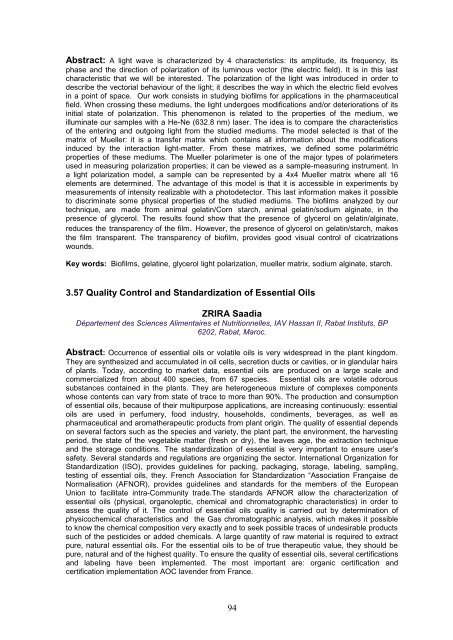Abstract Book - 3rd International Symposium on Medicinal Plants ...
Abstract Book - 3rd International Symposium on Medicinal Plants ...
Abstract Book - 3rd International Symposium on Medicinal Plants ...
You also want an ePaper? Increase the reach of your titles
YUMPU automatically turns print PDFs into web optimized ePapers that Google loves.
<str<strong>on</strong>g>Abstract</str<strong>on</strong>g>: A light wave is characterized by 4 characteristics: its amplitude, its frequency, its<br />
phase and the directi<strong>on</strong> of polarizati<strong>on</strong> of its luminous vector (the electric field). It is in this last<br />
characteristic that we will be interested. The polarizati<strong>on</strong> of the light was introduced in order to<br />
describe the vectorial behaviour of the light; it describes the way in which the electric field evolves<br />
in a point of space. Our work c<strong>on</strong>sists in studying biofilms for applicati<strong>on</strong>s in the pharmaceutical<br />
field. When crossing these mediums, the light undergoes modificati<strong>on</strong>s and/or deteriorati<strong>on</strong>s of its<br />
initial state of polarizati<strong>on</strong>. This phenomen<strong>on</strong> is related to the properties of the medium, we<br />
illuminate our samples with a He-Ne (632.8 nm) laser. The idea is to compare the characteristics<br />
of the entering and outgoing light from the studied mediums. The model selected is that of the<br />
matrix of Mueller: it is a transfer matrix which c<strong>on</strong>tains all informati<strong>on</strong> about the modificati<strong>on</strong>s<br />
induced by the interacti<strong>on</strong> light-matter. From these matrixes, we defined some polarimétric<br />
properties of these mediums. The Mueller polarimeter is <strong>on</strong>e of the major types of polarimeters<br />
used in measuring polarizati<strong>on</strong> properties; it can be viewed as a sample-measuring instrument. In<br />
a light polarizati<strong>on</strong> model, a sample can be represented by a 4x4 Mueller matrix where all 16<br />
elements are determined. The advantage of this model is that it is accessible in experiments by<br />
measurements of intensity realizable with a photodetector. This last informati<strong>on</strong> makes it possible<br />
to discriminate some physical properties of the studied mediums. The biofilms analyzed by our<br />
technique, are made from animal gelatin/Corn starch, animal gelatin/sodium alginate, in the<br />
presence of glycerol. The results found show that the presence of glycerol <strong>on</strong> gelatin/alginate,<br />
reduces the transparency of the film. However, the presence of glycerol <strong>on</strong> gelatin/starch, makes<br />
the film transparent. The transparency of biofilm, provides good visual c<strong>on</strong>trol of cicatrizati<strong>on</strong>s<br />
wounds.<br />
Key words: Biofilms, gelatine, glycerol light polarizati<strong>on</strong>, mueller matrix, sodium alginate, starch.<br />
3.57 Quality C<strong>on</strong>trol and Standardizati<strong>on</strong> of Essential Oils<br />
ZRIRA Saadia<br />
Département des Sciences Alimentaires et Nutriti<strong>on</strong>nelles, IAV Hassan II, Rabat Instituts, BP<br />
6202, Rabat, Maroc.<br />
<str<strong>on</strong>g>Abstract</str<strong>on</strong>g>: Occurrence of essential oils or volatile oils is very widespread in the plant kingdom.<br />
They are synthesized and accumulated in oil cells, secreti<strong>on</strong> ducts or cavities, or in glandular hairs<br />
of plants. Today, according to market data, essential oils are produced <strong>on</strong> a large scale and<br />
commercialized from about 400 species, from 67 species. Essential oils are volatile odorous<br />
substances c<strong>on</strong>tained in the plants. They are heterogeneous mixture of complexes comp<strong>on</strong>ents<br />
whose c<strong>on</strong>tents can vary from state of trace to more than 90%. The producti<strong>on</strong> and c<strong>on</strong>sumpti<strong>on</strong><br />
of essential oils, because of their multipurpose applicati<strong>on</strong>s, are increasing c<strong>on</strong>tinuously: essential<br />
oils are used in perfumery, food industry, households, c<strong>on</strong>diments, beverages, as well as<br />
pharmaceutical and aromatherapeutic products from plant origin. The quality of essential depends<br />
<strong>on</strong> several factors such as the species and variety, the plant part, the envir<strong>on</strong>ment, the harvesting<br />
period, the state of the vegetable matter (fresh or dry), the leaves age, the extracti<strong>on</strong> technique<br />
and the storage c<strong>on</strong>diti<strong>on</strong>s. The standardizati<strong>on</strong> of essential is very important to ensure user‟s<br />
safety. Several standards and regulati<strong>on</strong>s are organizing the sector. <str<strong>on</strong>g>Internati<strong>on</strong>al</str<strong>on</strong>g> Organizati<strong>on</strong> for<br />
Standardizati<strong>on</strong> (ISO), provides guidelines for packing, packaging, storage, labeling, sampling,<br />
testing of essential oils, they. French Associati<strong>on</strong> for Standardizati<strong>on</strong> “Associati<strong>on</strong> Française de<br />
Normalisati<strong>on</strong> (AFNOR), provides guidelines and standards for the members of the European<br />
Uni<strong>on</strong> to facilitate intra-Community trade.The standards AFNOR allow the characterizati<strong>on</strong> of<br />
essential oils (physical, organoleptic, chemical and chromatographic characteristics) in order to<br />
assess the quality of it. The c<strong>on</strong>trol of essential oils quality is carried out by determinati<strong>on</strong> of<br />
physicochemical characteristics and the Gas chromatographic analysis, which makes it possible<br />
to know the chemical compositi<strong>on</strong> very exactly and to seek possible traces of undesirable products<br />
such of the pesticides or added chemicals. A large quantity of raw material is required to extract<br />
pure, natural essential oils. For the essential oils to be of true therapeutic value, they should be<br />
pure, natural and of the highest quality. To ensure the quality of essential oils, several certificati<strong>on</strong>s<br />
and labeling have been implemented. The most important are: organic certificati<strong>on</strong> and<br />
certificati<strong>on</strong> implementati<strong>on</strong> AOC lavender from France.<br />
94

















